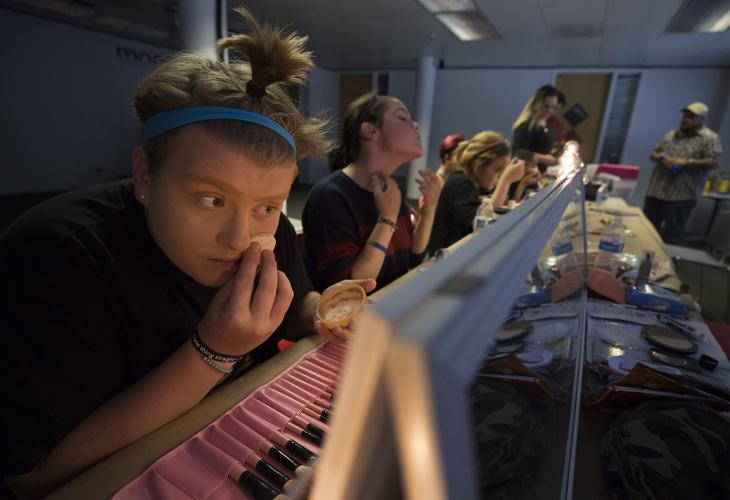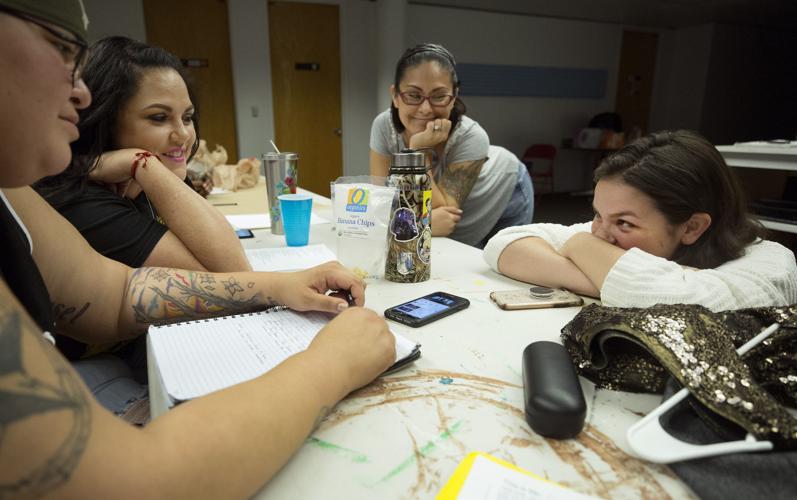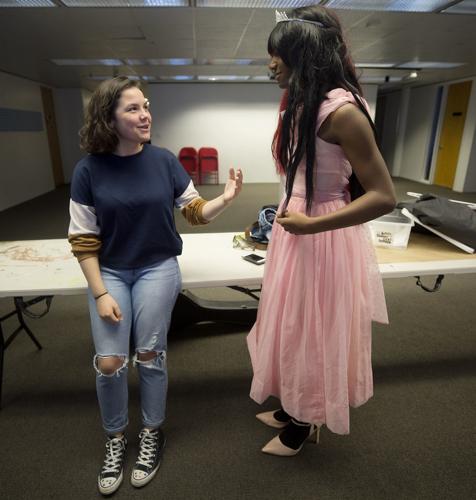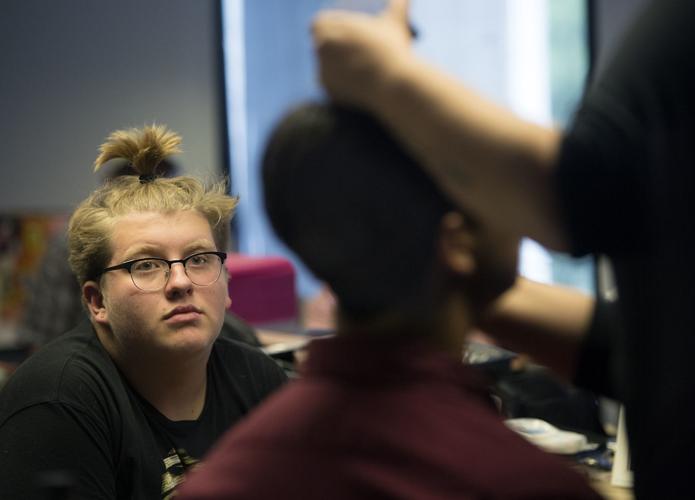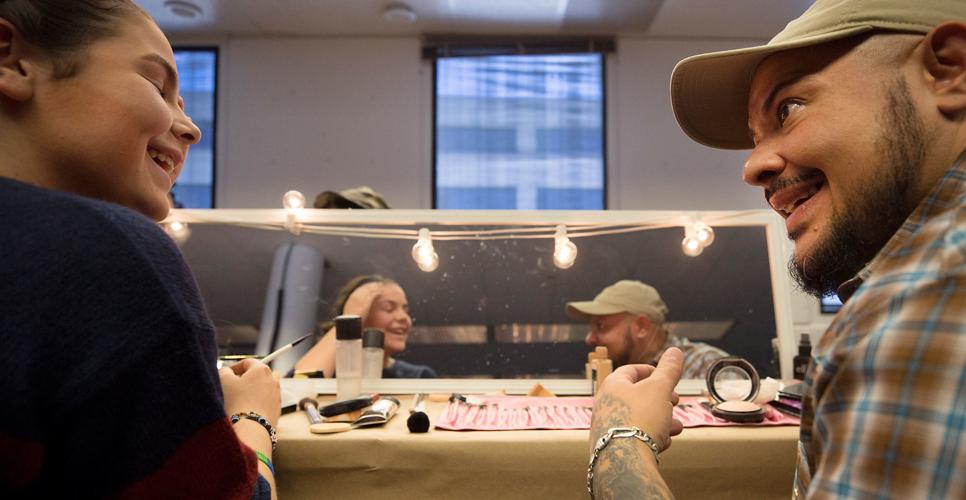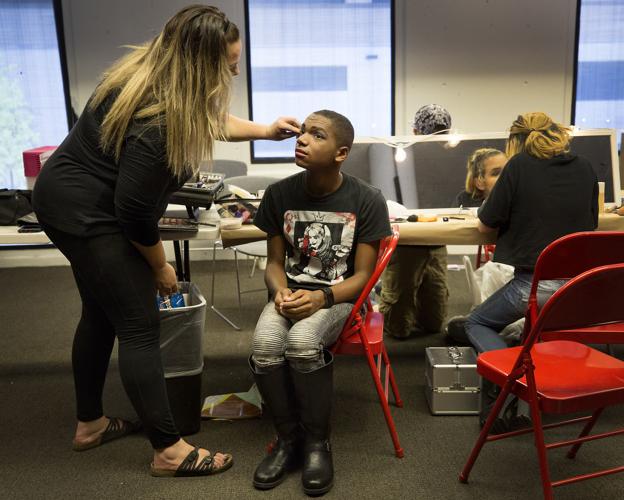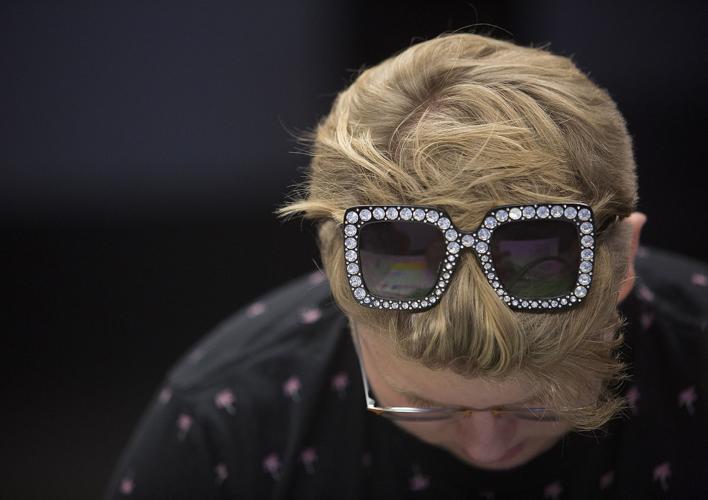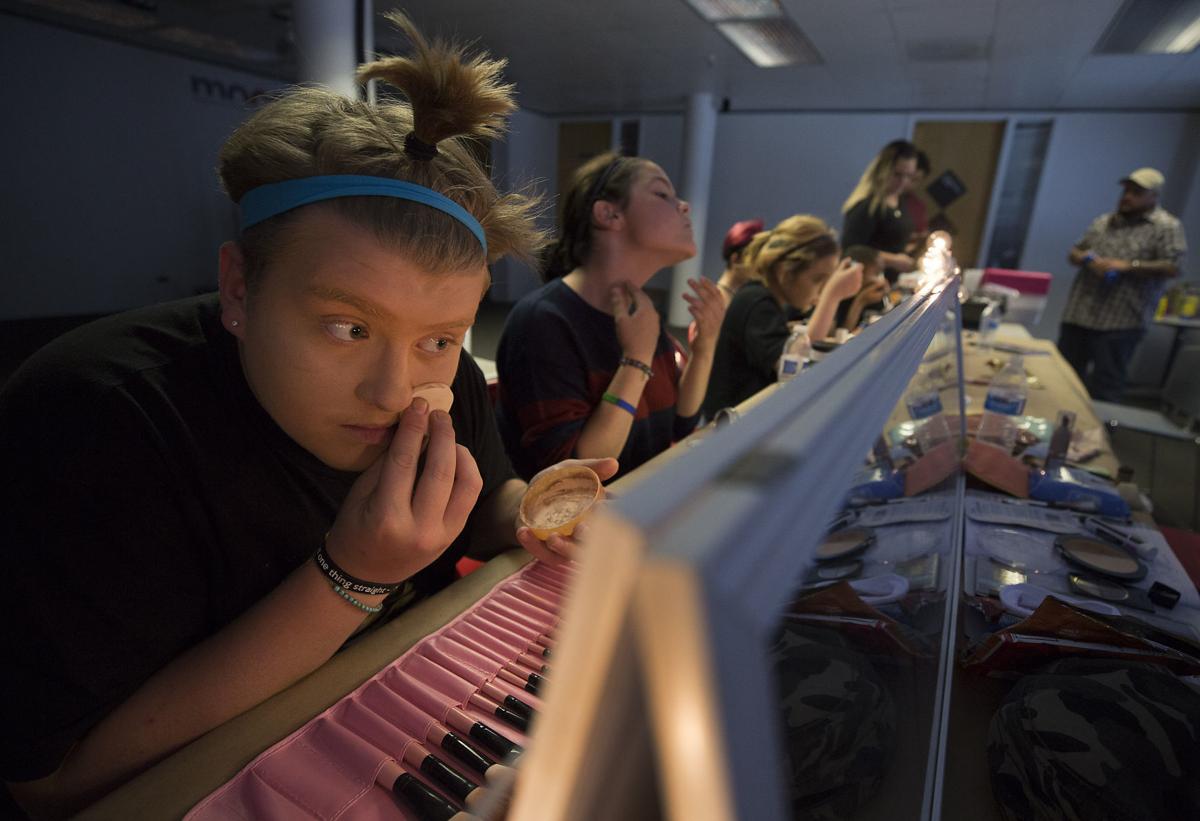It’s Sunday, Sept. 2, and about a dozen teens and preteens have gathered in an upstairs room of the Museum of Contemporary Art.
This is the first class for the School of Drag, which will teach 11- to 16-year-olds about the history of drag, makeup, costumes, wigs and dance. The 10-week program, headed up by the nonprofit Flux Productions, will culminate in a Nov. 17 drag performance by the students, who will be joined by Flux’s gender-bending performers, Boys R Us.
This first day is a gawky time for the 10 kids, most of whom don’t know each other. They exchange pleasantries but, with a few exceptions, they sit quietly in their seats and stare straight ahead until Dante Celeiro, who leads the class with other members of Boys R Us, speaks.
He gathers the group in a circle, introduces himself, gives his preferred gender pronoun, and asks everyone else to do the same.

Rose Chiasson, 14, right, uses a cellphone to play a song she wrote. Listening are, from left, Priscilla Varelas, Erin Armsey and Honey Ignacio.
Celeiro talks about the history of drag, about how it doesn’t just entertain, it can make political statements and illuminate struggles.
It is also a tool of expression, he says.
“Drag is not all about glitz and glamour,” he says. “Few people can make a living doing drag. This class is about you being yourself; to tell whatever story you want to tell.”
The students begin to loosen up some as they voice what they want out of the class.
“I want to learn makeup,” says Syd Clark-Yawitz, who turns 15 in December.
Others echo him.
“Drag is not just about makeup,” says Celeiro.
Rose Chiasson’s curiosity about drag was piqued when she watched the show “RuPaul’s Drag Race,” and this class seemed a natural progression.

Dante Celeiro, right, of the performance group Boys R Us, asks Rose Chiasson about what she’d like to learn during the School of Drag camp.
“I want to learn more about it, to try it. There’s no better thing to do than try,” the 14-year-old high school freshman says to a reporter. “I love the inclusiveness of it, and being true to yourself. The way it’s put together, the whole group has been really, really nice.”
Chiasson recently changed schools. The new school, and these classes, have given her a place to fit.
“I was an oddball in my last school. I was the one queer kid. I felt like an outcast. Now I have new friends and new experiences.”
The students become particularly animated when they begin the task of selecting music for their performances. Some will have solos, others will participate in group numbers. But all, it seems, are passionate about the music.
Black Eyed Peas, Nightcore and Ariana Grande are among the artists whose songs they will lip sync and perform to.
At the second class, most students are chattering like longtime friends, but when Erin Armsey hauls out her impressive makeup kit, all attention is on her. Armsey has done special-effects makeup for film and television, and she is a pro when it comes to that glam look.
She has coaxed her son Zachary to be her model and she begins to make him over. She talked through each step: “Bring the foundation down the neck,” she advises. “Don’t use a brush to apply powder.”
“Powder the eyelids.”
“Always use lip liner to keep your lipstick in place.”

Stefan Vikingur, 15, aka Miss Maura Plause, watches as Erin Armsey demonstrates makeup techniques on her son, Zachary, during a School of Drag session on Sept. 9, 2018. Vikingur is a returning student to the School of Drag.
After a few hours, Zachary, looking glamorous, rushes off to wash his face and the students turn to the small makeup mirrors set at each place. Armsey hands out sample eye makeup to augment the makeup kits most brought with them.
“What color, what color,” Clark-Yawitz asks no one in particular.
“I’m going for a wondrous look,” he explains. “People will look at me and go ‘wondrous.’”
Stefan Vikingur, who has his own well-stocked kit, is well into perfectly applying his makeup. He’s been doing it for five years, learning from online tutorials, the 15-year-old high school sophomore explains.
“I’ve been interested in drag for a while,” he says. “It’s a good way to express my nonbinary mind-set. Drag school is a good platform to perform on.”
As this second class winds up, Celeiro hands out homework: “Solidify the music, we’ll post the lyrics, listen to the songs you’ve selected.”
In subsequent weeks, students learn choreography; settle on wigs and costumes; practice walking and dancing in high heels; and rehearse, rehearse, rehearse.
As the performance grows closer, the numbers tighten up. Celeiro and his team from Boys R Us, who have watched over the teens with care and attention, heap praise on the performers.

Erin Armsey, a makeup artist and performer with Boys R Us, gives Syd Clark-Yawitz, 14, some makeup tips during the School of Drag camp at the Museum of Contemporary Art.
This is the second year Clark-Yawitz, who has about six costume changes for his numbers, has taken this class and he is in his element.
“It’s really fun,” he says with a broad smile.
“I really like doing drag. When you do it, you find yourself, find your purpose.”
One of his fathers performed drag, and he recognized in Clark-Yawitz a yearning that he had had.
“‘Why don’t you do drag,’” Clark-Yawitz says his father said a few years ago. “‘It has everything you like — dressing up, performing, makeup.’”
His stage name, Alison Blake, is a nod to Alice in Wonderland, one of his favorite characters, and his father, whose stage name was Nina Blake.
Clark-Yawitz, dressed in a lacy navy blue dress, pink heels and a long wig that is half-black, half-red, was getting ready to rehearse. He paused before he left for the makeshift stage.

Rose Chiasson, 14, left, aka Imogen’s Roses, and Syd Clark-Yawitz, 14, aka Alison Blake, catch up before the final dress rehearsal for the School of Drag Showcase.
“You can be yourself here,” he says looking around. “You don’t have to be afraid of who you are.”
Chiasson, who will perform an original song for the show, says she doesn’t think drag is for her. But the School of Drag has had a profound impact on her.
“It’s perspective changing,” she says. “I’ve learned more about drag, more about myself. ... I’ve met people who practice self-awareness and inclusiveness. These weeks have flown by.”
“These kids are just exploring,” says Celeiro. “They are so happy that they can just be, and they recognize that they are respected for just being.”

Stefan Vikingur, 15, aka Miss Maura Plause, says drag is “a good way to express my nonbinary mind-set. Drag school is a good platform to perform on.”


